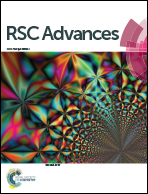Microstructural, rheological, and antibacterial properties of cross-linked chitosan emulgels†
Abstract
Antimicrobial emulgels were fabricated by cross-linking chitosan using cinnamaldehyde (CA) nanoemulsions. The influence of system composition and pH on the properties of the emulgels was characterized using electron and confocal fluorescence microscopy, dynamic shear rheology, and Fourier transform infrared spectroscopy (FT-IR). FT-IR confirmed the occurrence of a Schiff base reaction between chitosan and CA. Rheology measurements helped establish the optimum pH and system composition required to fabricate emulgels. Microscopy provided information about the network structure formed within lyophilized emulgels. The emulgels were shown to have strong antibacterial activity against E. coli and S. aureus.


 Please wait while we load your content...
Please wait while we load your content...